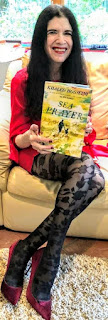The passage below is excerpted from the Article "Ba-Boom! EdTech!" which appeared in EdTech Digest July 12, 2019- Education’s explosive ‘next’
observed through the lens of ISTE 2019. UNPACKING EDTECH | by Mark Gura"
" At the annual ISTE Literacy
Network’s session, from a grab bag of “The New” conveniently squeezed into a
vision- and info-packed hour (actually, I produce this session for ISTE
personally), emerged an understanding of the new shape of Literacy
Instruction.
‘Technology Based Literacy Resources
and Practices with Special Promise’ aims to turn heads and drop a few jaws. It
offers solid examples of resources available to take literacy learning to next
levels of possibility. Sage Salvo, of Words Live, delivered big-time in
the first of the session’s four presentations.
Words Live
I think of Words Live as an engine
that delivers instant cultural relevance to lessons that otherwise would be
experienced by students as beyond the scope of their interest (boring!).
Accomplishing that is quite a feat. Words Live is an online resource that
supports teachers and students in easily matching text-based content items
being studied (think anchor texts, literary concepts, etc.) with
the music that kids are currently listening to—and quickly delivering, through
the work of its algorithm, standards-based lessons replete with video-embedded
slides that present analysis and examples of how the selected text aligns with
and is understood through songs that share themes, concepts, and literary
devices.
Words Live provides focus questions,
assessment suggestions, and a full complement of instructional assets. A
must-be-seen resource for today’s classrooms! Salvo, the creator of Words Live,
is an educational visionary with a background in entertainment and both feet
firmly planted in a mission to deliver precisely what today’s kids want and
need. https://www.wordsliive.org/
Timelooper
Timelooper, built on the session’s
increasing excitement with its extraordinary solution that applies VR/AR
technology to required curriculum. While many of us are still figuring out how
VR can most meaningfully be used to produce important learning experiences,
investments in precious student time and attention, that go beyond simply dazzling
us all with mind-bending visual effects, Timelooper elegantly addresses actual
classroom needs. It offers experiential instruction that transports students
into the startling reality of landmark historical events. Students explore
these in a virtual environment of extraordinary fidelity; an experience that
resonates deeply, taking them beyond the realm of traditionally learned
concepts and facts. The experiences crafted by Timelooper provide exciting
entry points for learning and applying communication skills: writing,
discussion, related readings, and more. No wonder the large number of literacy
educators present were transfixed. https://www.timelooper.com/educators
BirdBrain Technologies
BirdBrain Technologies, a student
robotics provider, pushed the literacy education parameters even further. One
of the most exciting recent developments in the area of Student Robotics is the
deep and meaningful connections made with Literacy Learning. BirdBrain
Technologies, particularly with its Hummingbird kit, has gone deep here,
developing practices in which students explore themes in literature and express
and illustrate their learning through designing and building robotic tableaus
(I think that term will work here) based on literary works (e.g., Poe’s
The Raven). Session participants were given a startling, robotics-driven,
easy-for-teachers-to-implement approach to Literacy Instruction that was both
unexpected and that offered a vision of what’s next for classrooms. https://www.birdbraintechnologies.com/
Nearpod
Rounding out the sessions offerings
was Nearpod a student engagement platform that makes technology integration
easy—something crucial, in my mind, as so many teachers are still leery of the
difficulty and complexity they think they must overcome to make technology part
of what they do. Nearpod is also a vast library of content and resources, and Amy
Brown demonstrated one of its instructional games in real, synchronous time
to the session’s audience who were quick to join the action projected up front
on the large screen. They interfaced with the excitement on screen instantly
with their phones and other mobile devices. Nearpod, a well-known resource,
continues to shape shift, expanding its very abundant body of content through
ongoing acquisition of instructional resources, such as Flocabulary. https://nearpod.com/
Innovative
Literacy Playground
In a STEM-centric learning
environment, nothing is more crucial to the body of knowledge students will use
throughout their lives than literacy skills. And while clearly, literacy itself
is being redefined by new capabilities and possibilities fueled by an ever more
functionally rich body of digital resources, the elements of reading, writing,
speaking, and listening (the four Pillars of Literacy), remain
crucial—although, taking on exciting new ways of manifesting themselves. This
was evident at the conference’s Innovative Literacy Playground. Among its
offerings:
Supporting Creative Communicators in
the Classroom – students communicate their learning through a design process (Melinda
Kolk) – Student Writing: Effective Strategies and Digital Tools for
Revision (Troy Hicks) – Student Voice and Choice via digital tools
action research demonstration (Heather Esposito, Allison Kreiss, and
Kelly Healey), Google Forms as a self-reflection tool in the writing
process (Jules Csillag), and VR Escape Room Game Creation (Jules Csillag).
For a full listing of playground presentations and full titles, click here. "

